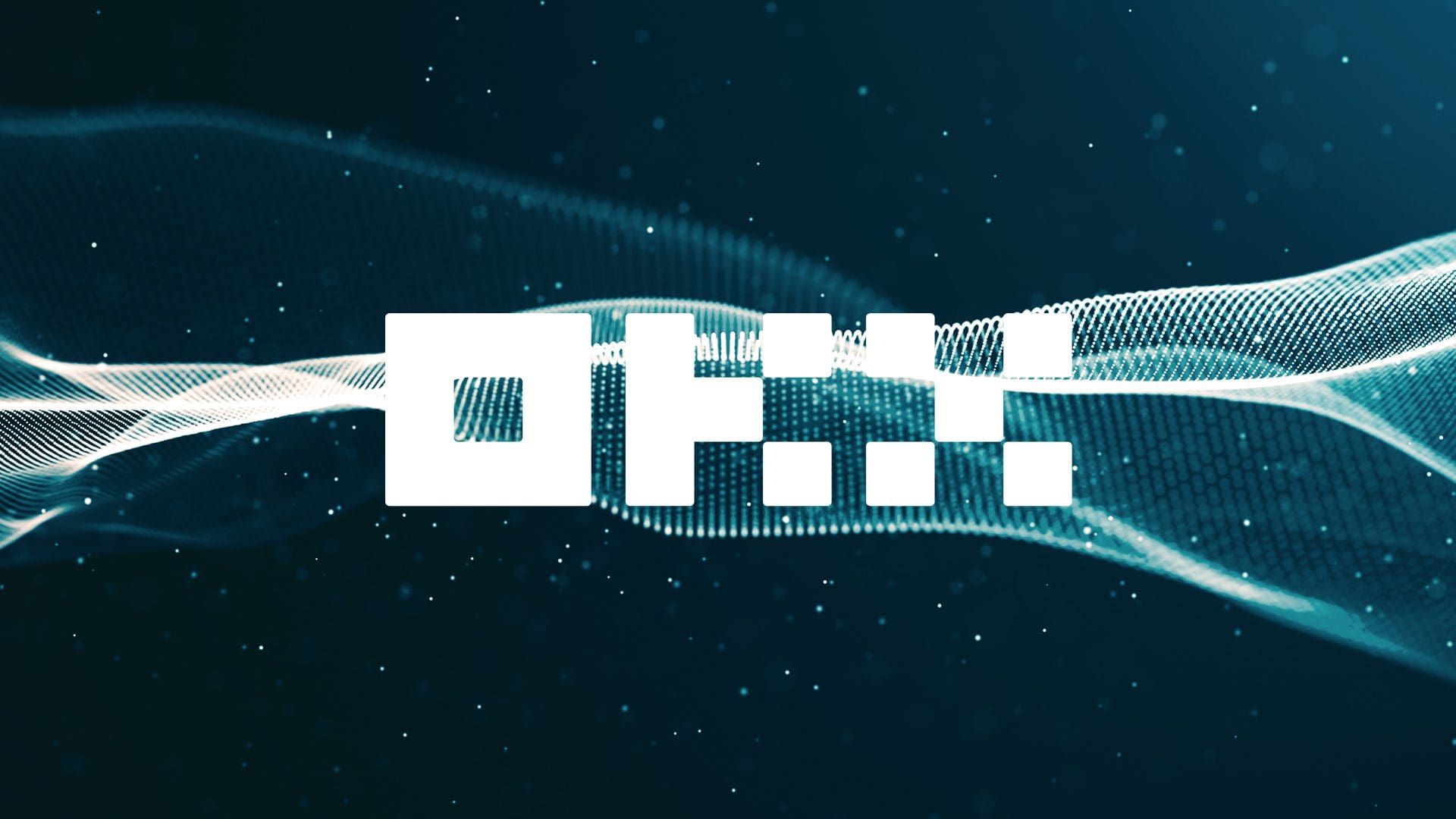OKX: an introduction
Among the leading crypto exchanges, OKX is one of the most comprehensive by far.
It lacks nothing in its offerings: cryptocurrency conversion, derivatives, bot trading and even automatic portfolio rebalancing. These features are then complemented by others such as earn.
The platform also hosts a section called Academy, containing various tutorials and very useful articles.
To top it off, there is the OKX Wallet, the multichain, non-custodial crypto wallet.
The premises look promising. All that remains is for us to take a deeper look at the OKX exchange, focusing mainly on security. Then space for the usual explanations of each feature.
Index
Overview of OKX
We could sum up OKX with one word: automation. Indeed, the exchange is known for offering programmable and automated value tools.
An example of this is portfolio rebalancing, which can be set either temporally or when a certain level is reached. In the former case, it would be rebalanced every few; on the other hand, in the latter case, changes would be triggered regardless of time (e.g., bitcoin goes up in price and exceeds the maximum threshold we set automatic rebalancing).
The offering is broad and starts from simple cryptocurrency swaps via Converti. All with zero fees and no slippage. Great for buying and selling coins and tokens quickly and easily.
Those who want something more comprehensive can instead operate from the basic Trading window, which is evolved but understandable even for a neophyte after a little study.
OKX, formerly OKEx, however, is at its best when you turn up the heat and trade more complex instruments: futures, perpetual swaps, margin, options… nothing is missing. The most demanding traders will be very happy.
In addition, the platform provides various types of trading bots and the user can even create a custom one. It seems superfluous but better to emphasize: you need the right knowledge, woe to improvise.
In the previous paragraph we mentioned security. Let’s find out how OKX protects the user.
First of all, needless to hide it: it is a centralized entity exactly like Binance, Kraken and Crypto.com. Therefore, should there be any insolvency problems, customers’ funds could be at risk.
That being said, let us assess the current situation.
OKX publishes its Proof of Reserves, taking advantage of the now well-known Merkle Tree. Each user can then see if his or her funds are actually covered by reserves, a situation that is essential to minimize problems.
The exchange explicitly states that “Your assets are backed 1:1 on OKX.” So while we will never have total security, we can be a little more comfortable.
On the cyber-security side, OKX has proven to be among the best players around. Clearly, even on this issue, the famous “ironclad” can never be achieved. Having a positive track record, however, is an added value compared to some competitors.
Moving on, the exchange proves careful to evolve all the time. As evidence of this we find the OKX Chain, a layer-1 network built on Cosmos, EVM and IBC compatible. The TVL is not huge but there is still some activity. The ecosystem hosts some DeFi, NFTs and gaming protocols, as well as bridges (including Multichain) and Web3 applications.
Well: now that we have read OKX’s ID card, let’s find out how to use the proposed functions. We start with the basics: fund deposit and coin and token swaps.
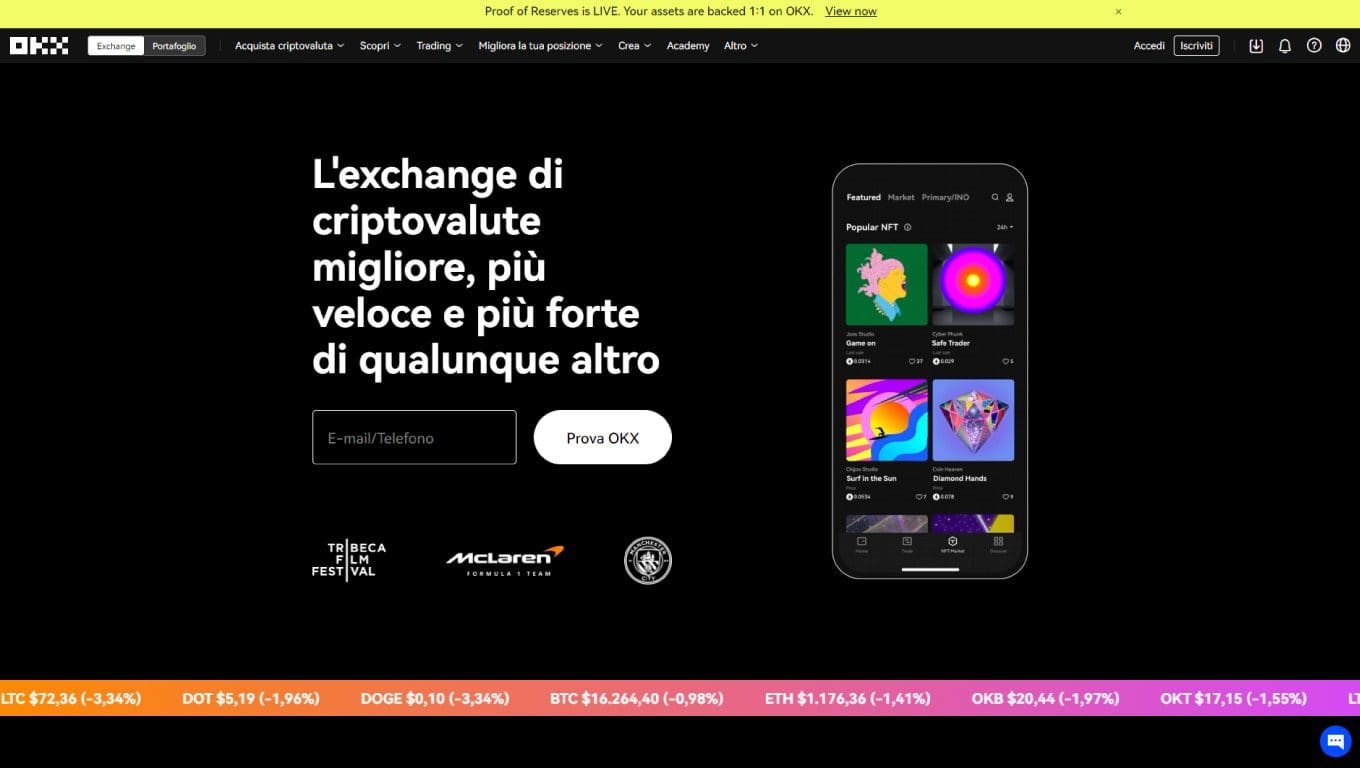
OKX Coin
Two lines on OKB, the exchange coin available on both OKEx Chain and Ethereum.
Total supply is 300 million, of which about 60 are in circulation at the time of writing (september 2024). The maximum supply, however, is not stated.
The OKX token is attractive especially for those who move large volumes and want to lower platform fees. However, we need to do some calculations before doing so, assessing the actual benefit.
In fact, by holding OKB we expose ourselves to its market fluctuations. Therefore, careful assessments of our portfolio allocation will be necessary.
Below is the real-time updated chart (source TradingView) on OKB’s performance.
How does OKEx work? Exchange crypto (basic)
Before we start trading and find out how OKX works, we will need to deposit some funds. The exchange offers several methods.
First and foremost is the deposit of cryptocurrencies from another wallet. We will just have to go to our assets, select Deposit and choose the one we want. After that we will be able to turn the funds over to OKX via blockchain, all very simple. Similarly, it will be possible to withdraw coins and tokens.
In case we do not have digital coins, we will have to click on the Buy cryptocurrency label located in the top menu. We will have three options:
- Buy by card: payment via VISA cards, Mastercard, Apple Pay and more;
- P2P trading: buying crypto directly from other users;
- Third-party payment: we turn to external services such as Banxa and Simplex.
Cards usually involve additional fees. The same applies to third-party services, which are usually even more expensive. Therefore, if possible, we opt for cryptocurrency transfer.
Now that we have funds, let’s look at the Convert feature, which is the most straightforward, easy and inexpensive.
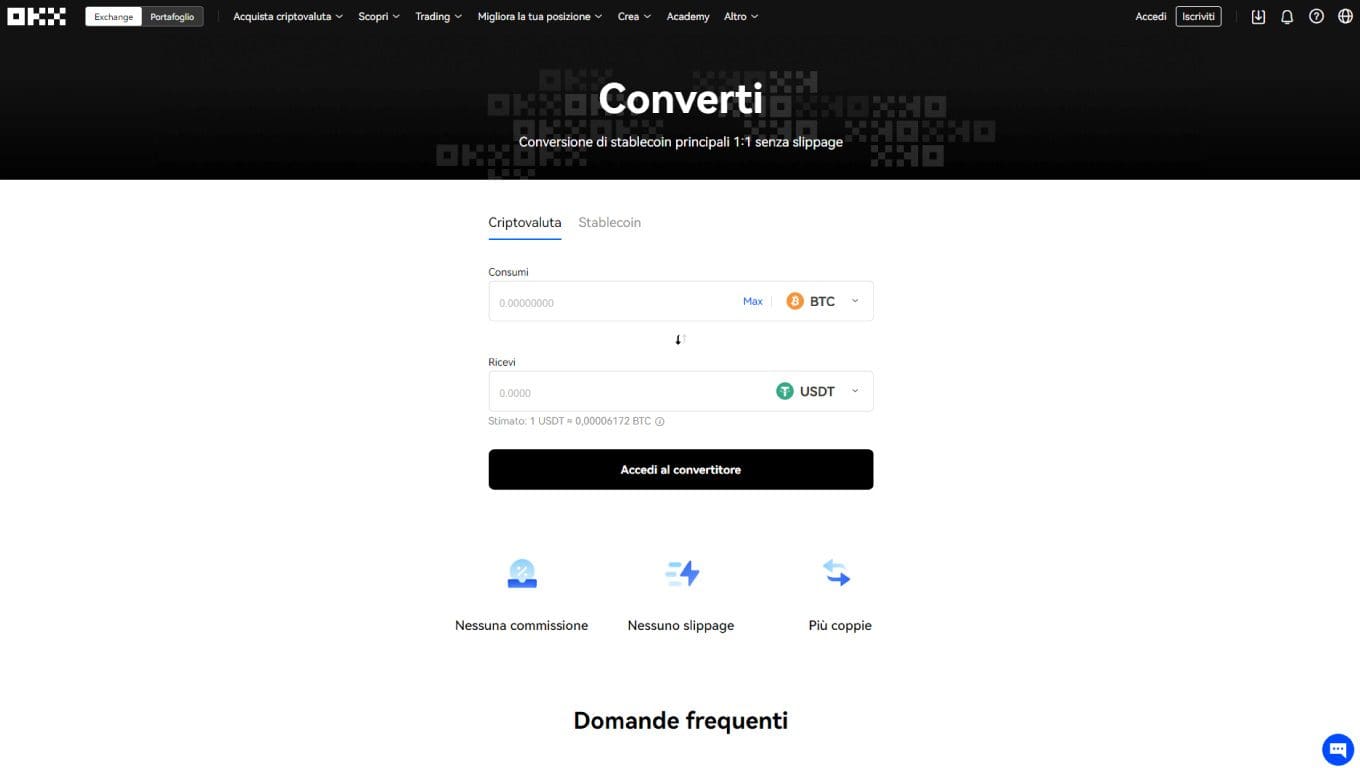
It takes very little to proceed:
- In the topmost box (see image above) we choose assets and amount to convert;
- In the section immediately below, we instead indicate the crypto we want to get in exchange;
- We confirm and we are already done. No fees or slippage.
The same applies to stablecoins. We will only have to click on the word Stablecoin to open the dedicated tab, nothing more.
The other method of trading coins and tokens, however, is basic trading.
From the menu, we click on Trading and then Basic Trading. This will open a much more complex screen, visible at the end of the paragraph. Let’s go through the various areas so we can figure out how to move around.
The left column is devoted to trading pairs.
We click on one of the many assets shown to view (again in the column) the proposed pairs; choosing one, the page will refresh and show what we want. By default, the page is set to the BTC/USDT pair (Tether’s stablecoin ).
In the center of the screen is placed the graph. Knowing how to read it is important, and this is where technical analysis and data interpretation comes in.
The chart is customizable and we can opt to view that of TradingView, among the best platforms around when it comes to analysis.
Below the chart is the area from which to set orders.
By itself, use is relatively easy: you set any limits, choose the amount, and hit the green or red button, depending on the type of trade.
However, the functionality is comprehensive and may confuse those with less experience. In fact, in addition to the classic market order, we find limits, stop loss, trailing stop and more. The only solution is to study the types of orders in trading and do some experimentation with very small amounts, better if followed by an experienced person.
In the meantime, we can always buy and sell cryptocurrencies through the simple Convert function seen earlier.
Concluding the overview, on the right side we find order book and transaction history. Here again you need some familiarity and knowledge to understand the data.
Finally, by scrolling down we will be able to see the history of our trades, those opened, closed, and bots as well.
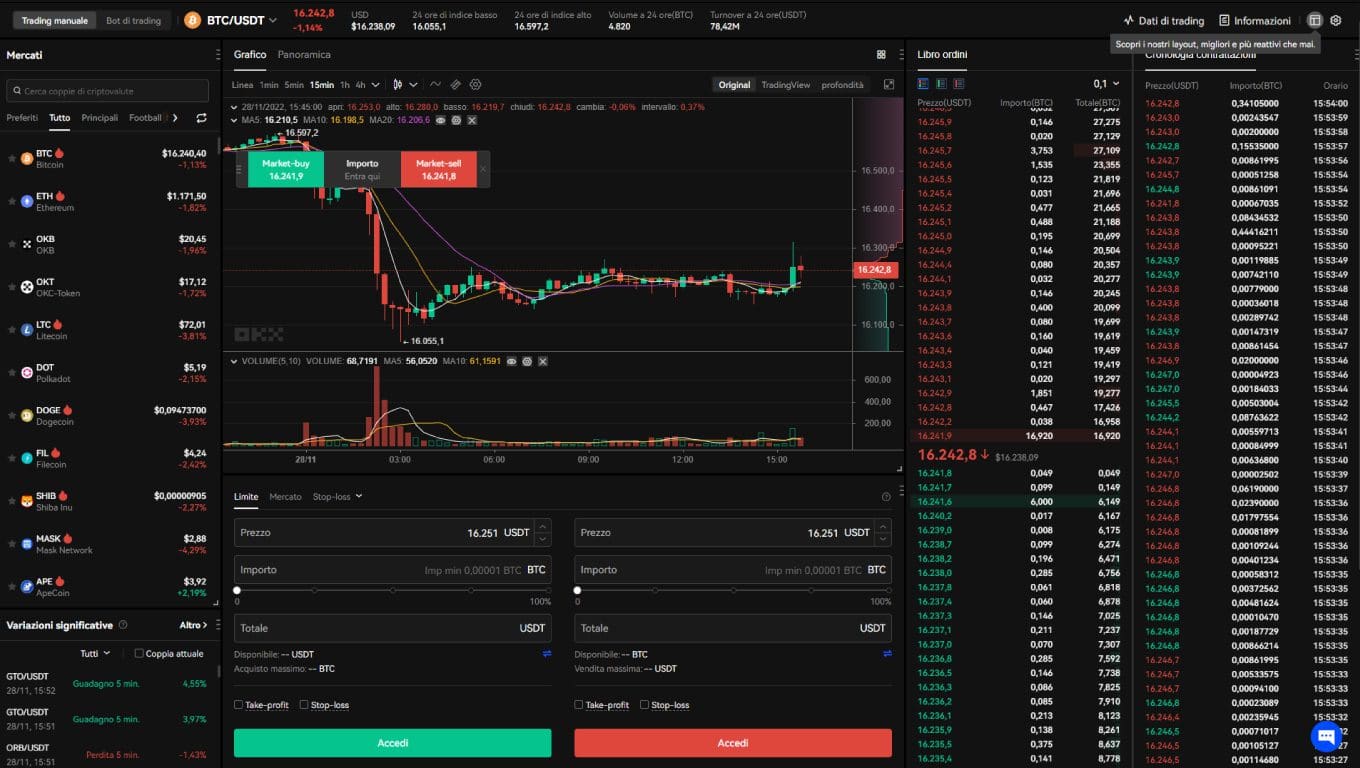
How do you withdraw from OKX?
Before we go any further, we absolutely must answer one question: how do we withdraw money from OKX?
From our assets, we select Withdraw and decide which coin will be affected by the move. We will also need to select the network on which we will rely, where possible. Remember that only cryptocurrency can be withdrawn with OKX.
Unlike deposits, withdrawals are subject to payment of a fee (which varies depending on numbers and blockchain).
For details, see the dedicated FAQ page.
Contracts and Margin Trading
Having filed the simpler tools, let’s deal with the more complex ones.
OKX offers the following:
- Perpetual swaps: derivative contracts on cryptocurrencies with maximum leverage that can be set at 125x. The market is operational 24/7;
- Futures: type of financial derivative on a variety of coins and tokens, at maturity. Leverage also up to 125x (be careful!);
- Margin: ability to trade using collateralized borrowing from one’s assets;
- Options.
All the products just listed are complex and not suitable for those without the right experience. In fact, factors such as leverage, opening positions with margin, short positions, etc. come into play. Therefore, it becomes easy to achieve losses if one cannot perfectly understand the mechanisms that distinguish the instruments in question.
The trading interface is almost identical to the one seen above.
"In the right hands, OKX's proposal poses no operational limits"
OKX Trading Bots
Could trading bots have been missing? Absolutely not: OKX has no intention of leaving any spaces uncovered.
For those unfamiliar with them, bots allow you to trade automatically. Since they are programs set to move in a certain way, they are able to maximize gains and trade with a frequency that is difficult for humans to achieve.
Let’s dispel a myth, however: trading bots try to limit losses in unfavorable contexts, this is true. However, let’s forget about insured gains; on the contrary, sometimes negative marks are cashed in big time.
We can say with certainty that the combination of right bot and timing brings good results. So, first we will still have to analyze the context and decide which is the correct bot for the situation at hand; then we can start it and let it run its course, trusting in the goodness of our analysis.
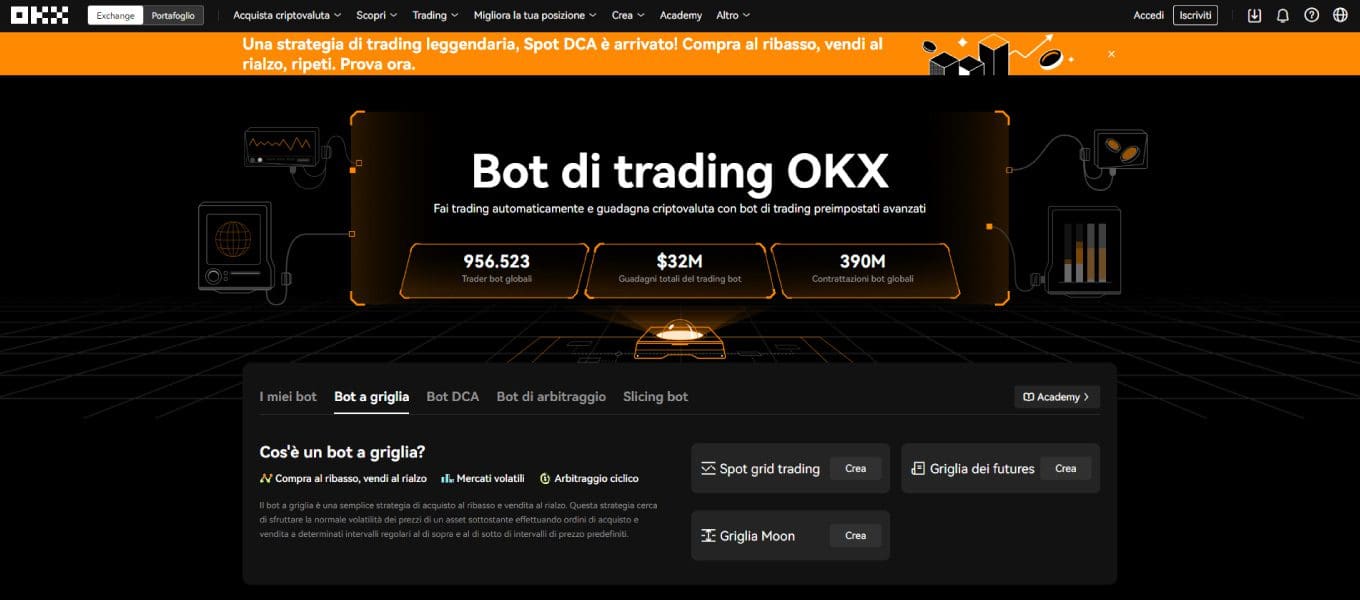
OKX makes several bots available to clients. The two best known are grid bots and DCA bots. These are then joined by arbitrage bots and slicing bots. Let’s get to know all four of them better.
We have already talked about grid bots several times.
Simplifying as much as possible, this bot applies a more or less dense grid to the trend chart of an asset’s value. After that, it buys or sells at certain levels, always with the goal of optimizing earnings.
To make it clear: a grid bot designed for a bullish phase will buy during corrections and sell in upturns. Again, this is a very simplified explanation, just so we understand each other.
In contrast, the DCA bot aims to contain the volatility of a currency. In fact, the acronym DCA actually stands for Dollar Cost Averaging.
It goes like this: the investor allocates a certain amount of money to the trade. After that, the bot divides it up and makes several entries into the market, respecting certain parameters and periodicity.
Arbitrage bots do exactly what the name says: arbitrage. They buy and sell at the same time the asset, trying to profit from price changes. These are usually small, and it is the continuous trading that makes the strategy profitable.
The complexity rises, mind you: parameters such as spreads, liquidity and fees must be monitored, so it is not to be taken lightly.
Finally, here we come to the slicing bot, designed to lower trading costs for investors moving large sums of money.
The four macro-families listed then break down into several different products.
The ability to copy others’ strategies is interesting.
From the marketplace bot (see image at the end of the paragraph) we can browse the “catalog” and decide if there is something that suits us. Positive aspect: by copying experienced and profitable users we might be able to make money; negative aspect: we would end up relying on a stranger and have no way to improve our knowledge.
In conclusion, we say that you can also create your own bot. In any case, let’s leave this work to the real experts: it takes very little to not get what we hoped for.
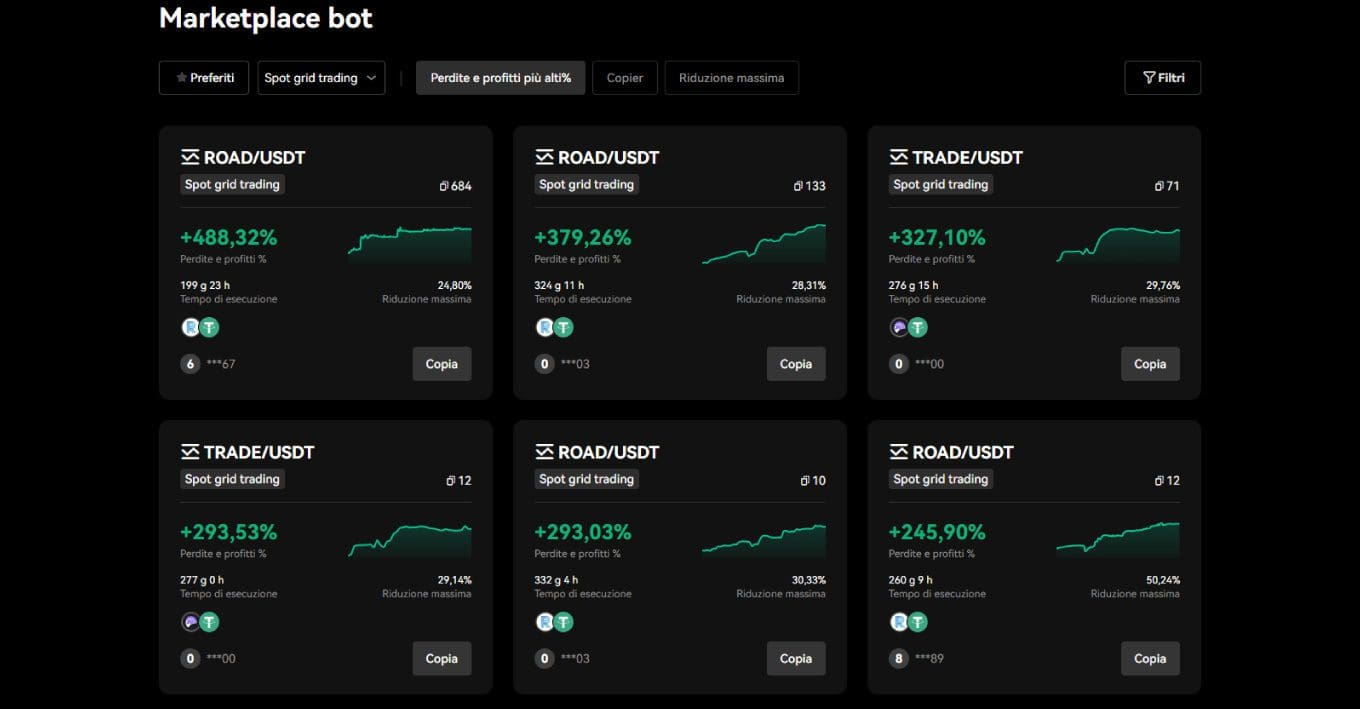
OKX Earn
Like any self-respecting exchange, OKX also has different types of earn. Users can choose the one they think is best and earn their cryptocurrencies.
From the site menu at the top, we place the mouse cursor over the words Improve your position to display the drop-down menu. Here we will find the various proposals.
Simple Earn allows us to annuitize our coins. The risks are listed as low, but beware: the coins remain locked in for the time selected during subscription (there are also flexible terms to avoid this). Therefore, we cannot in any way get our funds back before maturity.
On-chain Earn is OKX’s product that looks at DeFi. We will be able to stage single currencies, or opt for pairs. Income increases but, at the same time, we will also see increased risk.
Shark Fin allows you to invest your USDT and have your capital guaranteed, regardless of market conditions. Please refer to the dedicated page with attached FAQ to better understand how it works.
For the on-chain part, ETH 2.0 is the right place to stake Ethereum as low as 0.1 ETH.
Added to these products is the ability to borrow cryptocurrencies by providing collateral, an operation suitable for experienced users who want to set up multilevel strategies.
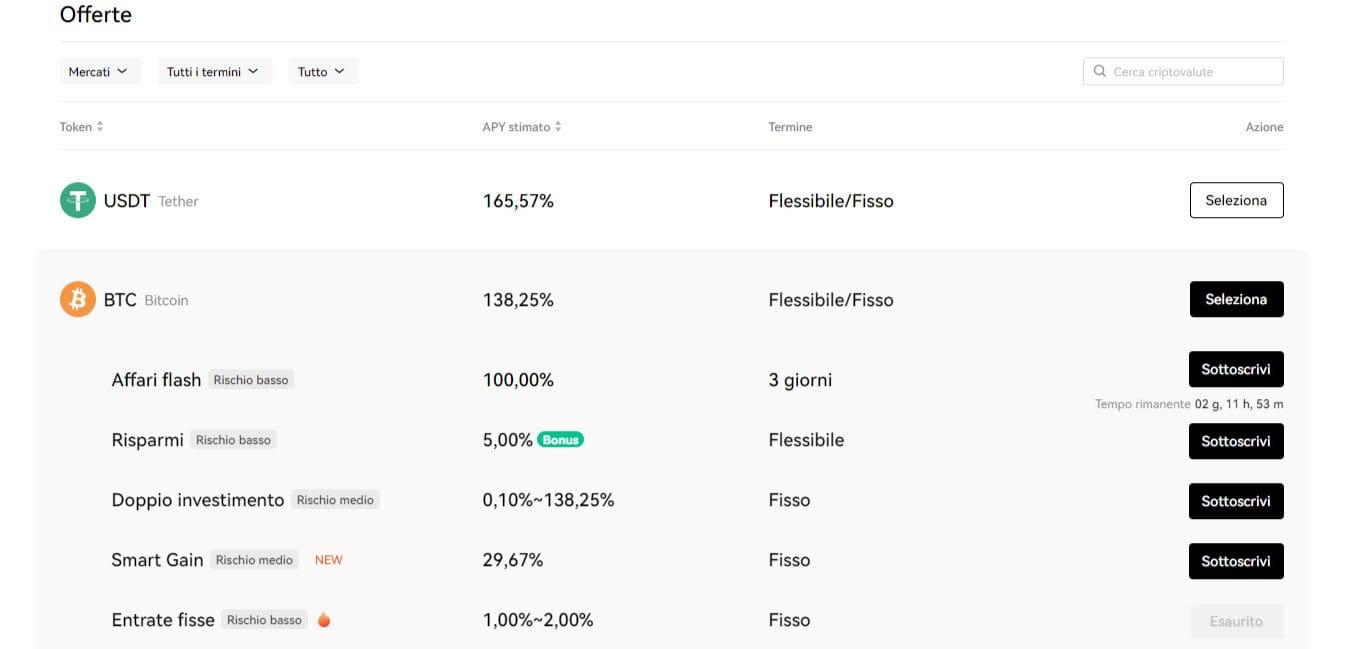
Fees and Commissions of OKX
Final chapter before final considerations: fees and commissions of OKX.
An exchange must offer its services at a competitive cost, or else its users will flee and liquidity will be lost. Let’s find out what fees we will have to incur by using OKX.
Starting with the spot market, we enter with a 0.08% maker and 0.1% taker fee. Both items can be cut by holding OKB, the platform’s coin. Of course, in addition to the actual convenience of buying OKB, keep in mind that we would be exposed to its price changes.
On futures and perpetuals we encounter even lower fees, another proof of how much OKX cares about these products. We start with 0.02% maker and 0.05% taker. For those in doubt, the maker is the one who sets limit orders; the taker operates at market instead.
Excellent base commissions on Options as well: 0.02% maker and 0.03% taker.
Daily withdrawal limit for any of the products just mentioned: 500 bitcoins.
VIPs, i.e., those who move large amounts of money, benefit from reduced commissions. In addition, they have higher than normal withdrawal limits.
To see the always up-to-date and comprehensive fees, here is the link to the OKX fee section of the official website.
Withdrawal fees, which are aligned with competitors, vary according to network congestion, so we cannot indicate them here.
"Very competitive fees make OKX an economical and viable exchange"
OKX Bonuses
OKX often has active promos for new users, including bonuses or referral codes to get a discount on fees.
Currently there is an active promo that allows you to get two mystery boxes each containing up to $10,000 in crypto, withdrawable!
The first box is given away immediately upon registration or download of the app. The second, after the first deposit and trade.
To get them, just register with this link: OKX bonus mystery box.
OKX: an exchange that lacks nothing
OKX is a good exchange, equipped with products that please everyone. Therein lies the strength: a comprehensive offering that leaves no one behind, from the novice to the trader with years of experience.
Spot? Futures? Options? Stake? Ask and you shall receive… really!
Do you want to sign up for OKX? Use this referral and get two mystery boxes worth up to $10,000.

